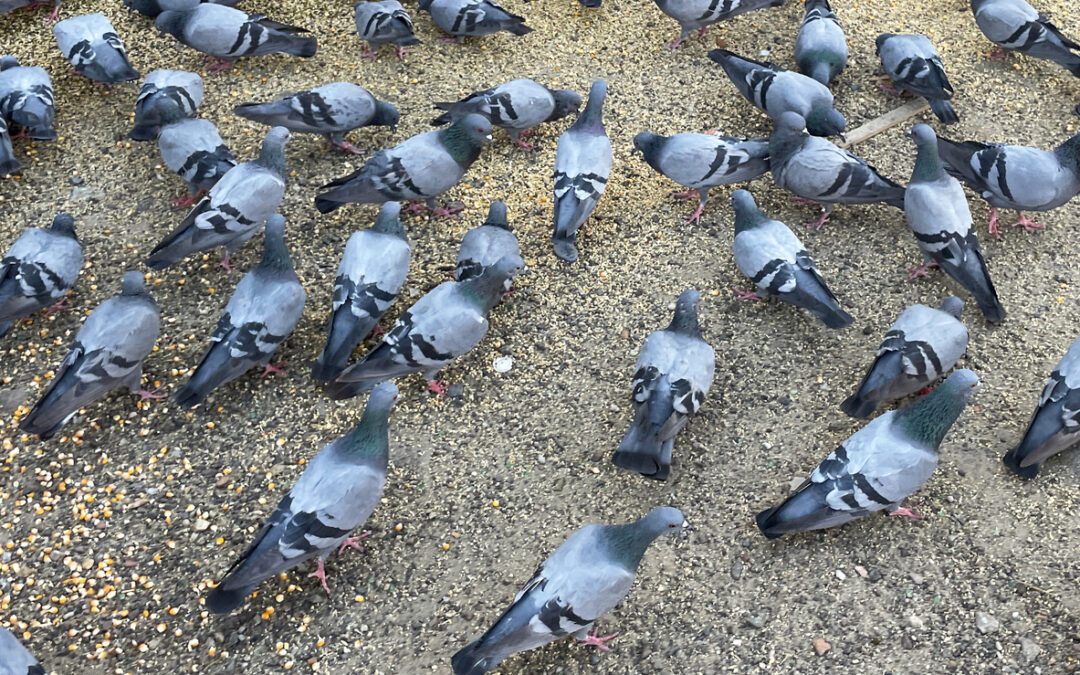
by Pigeon Patrol | Sep 25, 2024 | Bird Deterrent Products, Bird Law, Bird Netting, Columbidae
Pigeons are more often mocked than their avian brethren. But human beings have relied on pigeons for centuries to act as messengers, a reliable early post system — or in one case, a news bulletin. The birds possess remarkable navigation abilities, which is why on a summer morning in France in 1997, 60,000 pigeons were released to mark the centenary of the Royal Pigeon Racing Society with a cross channel flight. The problem? Most of them never came back. It was dubbed the “the great pigeon race disaster” and baffled experts and pigeon fanciers alike. But this week, OTM correspondent Micah Loewinger sits down with Robert Krulwich, co-creator and former co-host of Radiolab, and Jon Hagstrum, a geophysicist emeritus at the U.S. Geological Survey, to try and figure out exactly what exactly happened.
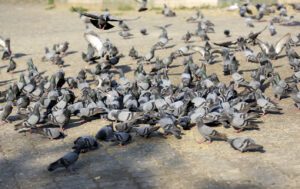
Flock of Pigeons crowded on the floor outdoor landscape close up.
Pigeon Patrol
Pigeon Patrol Products & Services is the leading manufacturer and distributor of bird deterrent (control) products in Canada. Pigeon Patrol products have solved pest bird problems in industrial, commercial, and residential settings since 2000, by using safe and humane bird deterrents with only bird and animal -friendly solutions. At Pigeon Patrol, we manufacture and offer a variety of bird deterrents, ranging from Ultra-flex Bird Spikes with UV protection, Bird Netting, 4-S Bird Gel and the best Ultrasonic and audible sound devices on the market today.
Canada’s top wholesaler for bird deterrent products for twelve consecutive years.
Contact us at 1- 877– 4– NO-BIRD, (604) 585-9279 or visit our website at https://www.pigeonpatrol.ca/
Bird Gone, Pigeon Gone, Pigeon problems, pigeon spikes, 1-877-4NO-BIRD, 4-S Gel, Bird Control, Pigeon Control, bird repellent, Bird Spikes, sonic bird repellent, stainless steel bird spikes, bird spikes Vancouver, Ultra Sonic Bird Control, Bird Netting, Plastic Bird Spikes, Canada bird spike deterrents, Pigeon Pests, B Gone Pigeon, Pigeon Patrol, pest controller, pest control operator, pest control technician, Pigeon Control Products, humane pigeon spikes, pigeon deterrents, pigeon traps, Pigeon repellents, Sound & Laser Deterrents, wildlife control, raccoon, skunk, squirrel deterrent, De-Fence Spikes, Dragons Den, Pigeon, Pigeon Patrol, Pigeons Roosting, Vancouver Pigeon Control, Bird Spikes, Bird Control, Bird Deterrent, Pigeon Deterrent, Surrey Pigeon Control, Pest, Seagull deterrent Vancouver Pigeon Blog, Birds Inside Home De-fence, Pigeon Nesting, Bird Droppings, Pigeon Dropping, woodpecker control, Keep The Birds Away, Birds/rats, seagull, pigeon, woodpecker, dove, sparrow, pidgeon control, pidgeon problem, pidgeon control, flying rats, pigeon Problems, bird netting, bird gel, bird spray, bird nails, bird guard, Pigeon control, Bird deterrents, Pigeon deterrents, Bird control, solutions, Pigeon prevention, Pigeon repellent, Bird proofing, Pest bird management, Pigeon spikes, Bird netting, Humane bird control, Bird exclusion, Urban bird control, Anti-roosting devices, Pigeon removal, Bird barriers
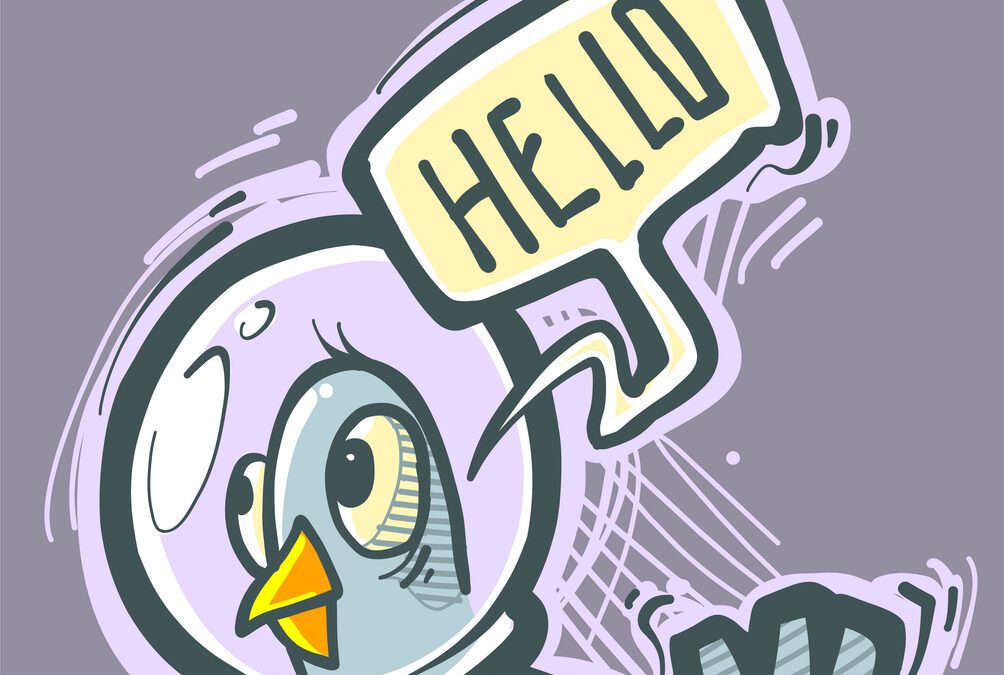
by Pigeon Patrol | Sep 25, 2024 | Bird Deterrent Products, Bird Netting, Bird Spike, Bird Spikes, Pigeons, Pigeons in the News
In a messy but unsuccessful war against pigeons on city buildings, Denver has tried highfrequency sirens, electrified toe strips and an anti-perching product called Hot Foot. But now city officials think they finally have found a weapon that works: hallucinogenic chemicals.
For the past year, the city has been feeding pigeons corn laced with a substance called Avitrol, which sends birds into convulsions, sometimes fatal, that scare away the rest of the flock.
With so many pigeons on bad trips, city workers say it’s the first time in memory that people can walk without fear of plops from the ledges, windowsills and outcroppings of the ornate City and County Building and Greek Theater.

Hand-drawn funny cute illustration – Curious pigeons.
The acidity in pigeon droppings had become such a potent problem that the city is spending $100,000 this summer to power-wash bird scat from buildings around Civic Center.
“It got to the point where you felt like you needed ski goggles to look up at the City and County Building,” said John Hall, manager of public office buildings for Denver. “Pigeons are urban vermin.”
Though the same Avitrol chemical also is being used against pigeons at Coors Field, St. John’s Episcopal Cathedral and Rose Medical Center, not everyone is convinced it’s the No. 1 solution to the No. 2 problem.
Just a few blocks across Civic Center, state maintenance workers worry that Denver Mayor Wellington Webb merely is scattering pigeons from his building to do their business on the state Capitol.
And animal-rights activists are aghast.
“It takes 40 pigeons pooping all day in one place to equal what a dog leaves on my lawn in one drop,” said Catherine Hurlbutt, 87, who has rescued and nurtured hundreds of injured birds at her south Denver home. “You’re not supposed to say a bad word about dogs, but people think it’s OK to poison pigeons.”
When New York City residents started using Avitrol on pigeons, Grace Slick, the famed Jefferson Airplane singer of the ’60s drug anthem “White Rabbit,” protested to Mayor Rudy Giuliani in a letter.
“I have considerable experience on the subject of mind-altering drugs, and I can tell you that Avitrol is not your run-of-the-mill hallucinogen,” Slick wrote. “It causes violent shaking, trembling, thirst, nausea, convulsions, disorientation and a slow death. Wow, talk about a bad trip!”
Last year, the New York State Assembly passed a bill allowing cities to ban Avitrol, but Gov. George Pataki, heeding a request from Giuliani, vetoed the bill.
All the flap is over a 1-pound bird that was native to Europe but brought to North America in the 1600s.
Supporters call them rock doves, which mate for life and feed milk to their young, and note that their homing ancestors helped in World War II by transporting spy messages. Detractors liken them to rats and cockroaches that carry diseases and dive-bomb passers-by with fecal glop.
Denver has struggled for decades to keep Downtown pigeons under control. When workers put spikes on building ledges to keep pigeons from roosting, the birds simply built nests atop them and enjoyed air-cooled nests in the summer. When workers tried a chemical spread called Hot Foot, birds built new nests and enjoyed warmer roosts for the winter.
When world leaders visited Denver for the Summit of the Eight in 1997, city workers installed electrified wires atop ledges favored by pigeons at Civic Center’s outdoor Greek Theater. The wires suffered from frequent short-circuits.
High-frequency radio speakers were supposed to drive the pigeons batty, but the birds ended up perching atop them anyway.
City officials said their war against pigeons seemed lost – until Denver hired the Pigeon Man.
The latest owner of a 47-year-old family business called Bird Control, Doug Stewart said Avitrol is one of his most effective tools against pigeons. When he started working for Denver a year ago, the City and County Building was home to hundreds of pigeons.
But with a $250-a-month city contract, Stewart started sprinkling Avitrol-laced corn on the roof of city hall. Recently, Stewart scrambled across the roof of the four-story building with his monthly dosage of bait in his backpack.
While the rooftop view of the Rocky Mountains to the west and the state Capitol to the east was magnificent, Stewart was most proud of something he didn’t see.
There were few birds, or fresh droppings, anywhere.
So he laid down a few small piles of Avitrol-laced corn, which costs him $50 a pound, and talked about a job that has taken him across the rooftops of the city, from Lakeside Mall to the steeple at St. John’s Episcopal Cathedral – and some truly disgusting abandoned apartment buildings in-between.
“I get asked all the time: Am I killing pigeons?” Stewart said. “There’s no way in the world I want any dead pigeons. I want to keep them fat, happy and on the move. It’s good for my business.” According to the government-approved warning label, Avitrol is a “poison with flock-alarming properties, used for the control of feral pigeons in, on, or in the area of structures, feeding, nesting, loafing and roosting sites, in such a way that a part of the flock may react and frighten the rest away. Birds that react and alarm a flock usually die.”
Scientific studies show the chemical temporarily alters brain waves and throws the bird into spasms and convulsions. When an Ontario, Canada, environmental official banned the use of non-humane vertebrate pesticides in 1975, a team of University of Ottawa researchers concluded that Avitrol “appears to be humane based on scientific evidence.”
“Upon eating the active ingredient of Avitrol in a corncob base, the birds begin to flap wings, vocalize and convulse,” said the study led by pathologist Henry Roswell.
“Other birds seeing this activity in their colleagues become alarmed and fly away to another area.” Critics of the use of bird repellants such as Avitrol claim that their use merely shifts birds from one area to another.
“Avitrol is not intended to kill birds. However, some do die, although the numbers are minimal in comparison to the hundreds that make up the flock,” Roswell said.
Death-rate estimates range from 1 percent to 20 percent of pigeons consuming Avitrol.
Meanwhile, workers at the Colorado Capitol wonder whether the city is dropping its pigeon problem on the state. In the past year, state workers have installed five special anti-pigeon Plexiglas barriers – at a cost of $300 each – on ledges above the Capitol’s west steps. When told Denver has been using a chemical that may be moving city birds to the state Capitol, state central services director Rick Malinowski said, “Thanks a lot! We may have to retaliate.”
City workers fear the consequences. At the city’s Greek Theater, maintenance worker Ray Martinez set down his coffee cup one morning on an outdoor step before walking inside an office.
When he returned to his coffee cup a few minutes later, he saw something that jolted him awake.
“I was ready to take a sip and I looked down and thought, “Hey, what’s going on here? I take my coffee black!’
” Martinez said. “I was so mad I threw my cup at that bird.”
Pigeon Patrol
Pigeon Patrol Products & Services is the leading manufacturer and distributor of bird deterrent (control) products in Canada. Pigeon Patrol products have solved pest bird problems in industrial, commercial, and residential settings since 2000, by using safe and humane bird deterrents with only bird and animal -friendly solutions. At Pigeon Patrol, we manufacture and offer a variety of bird deterrents, ranging from Ultra-flex Bird Spikes with UV protection, Bird Netting, 4-S Bird Gel and the best Ultrasonic and audible sound devices on the market today.
Canada’s top wholesaler for bird deterrent products for twelve consecutive years.
Contact us at 1- 877– 4– NO-BIRD, (604) 585-9279 or visit our website at https://www.pigeonpatrol.ca/
Bird Gone, Pigeon Gone, Pigeon problems, pigeon spikes, 1-877-4NO-BIRD, 4-S Gel, Bird Control, Pigeon Control, bird repellent, Bird Spikes, sonic bird repellent, stainless steel bird spikes, bird spikes Vancouver, Ultra Sonic Bird Control, Bird Netting, Plastic Bird Spikes, Canada bird spike deterrents, Pigeon Pests, B Gone Pigeon, Pigeon Patrol, pest controller, pest control operator, pest control technician, Pigeon Control Products, humane pigeon spikes, pigeon deterrents, pigeon traps, Pigeon repellents, Sound & Laser Deterrents, wildlife control, raccoon, skunk, squirrel deterrent, De-Fence Spikes, Dragons Den, Pigeon, Pigeon Patrol, Pigeons Roosting, Vancouver Pigeon Control, Bird Spikes, Bird Control, Bird Deterrent, Pigeon Deterrent, Surrey Pigeon Control, Pest, Seagull deterrent Vancouver Pigeon Blog, Birds Inside Home De-fence, Pigeon Nesting, Bird Droppings, Pigeon Dropping, woodpecker control, Keep The Birds Away, Birds/rats, seagull, pigeon, woodpecker, dove, sparrow, pidgeon control, pidgeon problem, pidgeon control, flying rats, pigeon Problems, bird netting, bird gel, bird spray, bird nails, bird guard, Pigeon control, Bird deterrents, Pigeon deterrents, Bird control, solutions, Pigeon prevention, Pigeon repellent, Bird proofing, Pest bird management, Pigeon spikes, Bird netting, Humane bird control, Bird exclusion, Urban bird control, Anti-roosting devices, Pigeon removal, Bird barriers
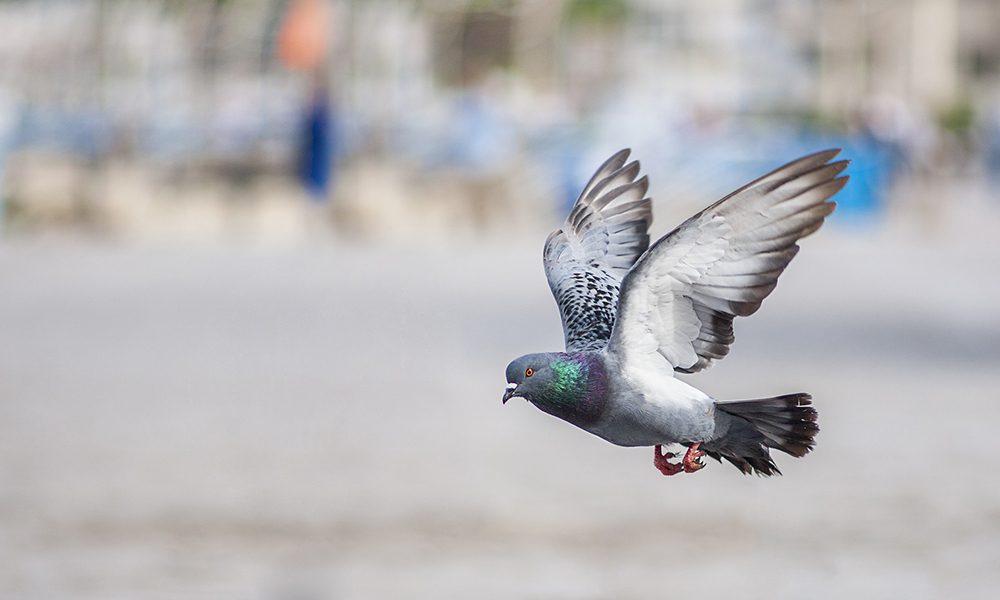
by Pigeon Patrol | Sep 25, 2024 | 4-S Gel Bird repellent, Animal Deterrent Products, Bird Deterrent Products, Bird Netting
A study on a population of pigeons on the University of South Africa’s Muckleneuk campus was conducted over 2 years. Counts were conducted during a baseline year (March 2013–February 2014) to establish the pigeon population index inhabiting the campus buildings, and again in the management year (August 2014–August 2015) once Eagle Eyes™, Fire (Flash) Flags, bird spikes and a combination thereof were implemented on the buildings. An efficacy reduction percentage was determined for each of the control structures. The total pigeon index on the campus declined by 50 % once the control structures were implemented. Control structures; however, differed markedly in efficacy from each other. Whilst bird spikes indicated the highest efficacy at reducing the pigeon population index, seasonality also influenced the efficacy of the control structure. Quantified understanding of the efficacy of pigeon control measures allows urban management to make informed decisions about reducing pigeon populations.
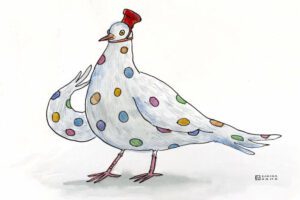
Background
Feral pigeons were first introduced by early Europeans to Southern Africa as a free-flying domesticated species in the seventeenth century (Brooke 1981). However populations both feral (Columba livia Gmelin 1789) and indigenous (speckled pigeon Columba guinea Linnaeus 1758) have since populated urban regions throughout the subcontinent. Urban resources and lifestyles associated with human activity have enabled pigeons to establish populations as a result of the available supply and distribution of food and breeding space (Haag-Wackernagel 1995) resulting in them being considered as the most successful avian coloniser of urban spaces.
Given their long history with humans (Sossinka 1982), it is surprising that pigeons were only first considered to be problematic to the human environment in the 1930s (Sacchi et al. 2002). As pigeon populations increase people start experiencing aesthetic, vital and economic conflicts of interest (Wetherbee et al. 1964) which include the exposure to droppings and debris accumulation (Murton et al. 1972; Fitzwater 1988; Flannery 2009), public health concerns (Hutton 2005; Haag-Wackernagel and Bircher 2009), disturbance (Hutton 2005; Haag-Wackernagel and Geigenfeind 2008), structural deterioration (Hutton 2005; Giunchi et al. 2012) and to a lesser extent, bird strikes (Giunchi et al. 2012). Large flocks of pigeons have been considered to be a nuisance due to their vocalisations (Carle 1959), disturbance from squabs and breeding activities (Hutton 2005), begging (Hutton 2005), potential transmission of pathogens and parasites (Haag-Wackernagel and Moch 2004) and their sheer numbers resulting in an altered enjoyment of private and public spaces (McKeown 2008).
Pigeon control has increased substantially over the decades (Giunchi et al. 2007), with the pigeon control industry booming in the twenty-first century when public views of the birds became increasingly negative and there were calls for the systematic extermination of pigeons in urban environments (Jerolmack 2008). Subsequently, with the increase in pigeon population densities, more pest control strategies have become readily available (Giunchi et al. 2012). These control strategies have been broadly directed at either reducing pigeon numbers through increasing mortality (Haag-Wackernagel 2008; Giunchi et al. 2012), decreasing natality (Giunchi et al. 2007a, b; Haag-Wackernagel 2008; Dobeic et al. 2011) or modifying behaviour through resource management (Haag-Wackernagel 1995; Giunchi et al. 2007a, b; Haag-Wackernagel 2008). Pigeon control is often ad hoc, reactive and unsustainable (Brix et al. 2006), aimed at short-term benefit to enable continued support for pest control businesses (Murton et al. 1972).
Lethal measures have become increasingly controversial and have lost public support (Treves and Noughton-Treves 2005), while non-lethal forms of control are sustainably effective in the long term and are more acceptable to the greater public (Murton et al. 1972; Haag-Wackernagel 1984). This is particularly applicable in light of the recent listing of the feral pigeon as a Category 3 invasive species in South Africa, in terms of the Alien and Invasive Species Regulations, 2014, in terms of the National Environmental Management: Biodiversity Act of 2004 (Act 10 of 2004) of South Africa which permits the legal control of feral pigeons in urban areas (Department of Environmental Affairs 2015; SA 2015: 493).
Non-lethal pigeon control strategies are generally directed at the pigeons’ visual, auditory and tactile senses; however, habitat modification and reduction can also be achieved by physical barriers. According to Jacobs (1992), pigeons are able to see in colour and ultra-violet spectrums to aid foraging, signalling and sex recognition, and thus visual control strategies aimed at irritating or impersonating danger have varying colour spectrums. These include decoys (Harris and Davies 1998), moving lights and objects, lasers (Blackwell et al. 2002), threatening images and reflective items. Hutton and Dobson (1993) and Hutton (2005) have both found that visual deterrents have their limitations and are generally ineffective due to habituation by the pigeons.
Habitat modification through the placement of physical barriers preventing pigeons from perching on buildings and other urban structures are used widely due to their durability and acceptance by the public (Giunchi et al. 2012). Haag-Wackernagel and Geigenfeind (2008) suggest that through the restriction of entrance dimensions and the exaggeration of sloping surfaces, access prevention to ideal roosting and nesting sites can be achieved. Anti-perching devices such as sprung wires (Hutton 2005) and bird spikes (Seamans et al. 2007), or the total exclusion through netting (Hutton and Dobson 1993) can be used to deter pigeons from making use of buildings in urban environments. Cost may be a limiting factor in their implementation, and the effectiveness of these barriers can depreciate over time if these devices are not maintained (Hutton 2005).
Nevertheless, every structure and strategy has its advantages and disadvantages (Hutton and Dobson 1993). However, regardless of the control method used, if the benefits of the resources for the pigeons outweigh the costs of enduring device-related discomfort, pigeons will override any system (Haag-Wackernagel and Geigenfeind 2008). Research suggests that science seems to be lacking in quantitative reviews of various control methods and their effectiveness at reducing pigeon populations (Buijs and Van Wijnen 2001; Fukuda et al. 2008). The level of pigeon reduction of such devices needs to be quantified so that urban management can make informed decisions about the cost effectiveness and efficacy at reducing pigeon populations with regard to non-lethal control methods.
The University of South Africa’s (Unisa) Muckleneuk campus in Pretoria is host to a large number of pigeons. The birds gain access into the buildings through open access points such as loose exterior ceiling boards and open electrical and air conditioning ducts (cabling ducts) positioned on the exterior of the buildings. This easy access increases the number of protected and sheltered breeding and roosting sites available. It has also increased health concerns relating to the build-up of their faeces and associated fungi, nest mites and bird lice which have been reported to infest the offices and affect the staff working in certain buildings on campus. Faeces and accumulated nesting material build-up on the various external structures of the campus buildings have become an issue of concern. According to Ntshoe (pers. comm. 2013), large financial investments have been made in order to manage the birds and their associated problems on an ad hoc and reactive basis.
This paper evaluates non-lethal humane pigeon control strategies with particular focus on visual deterrents and physical barriers on the Unisa Muckleneuk campus and will examine the following objectives and null hypothesis.
Objectives
To determine if the control structures have decreased the pigeon population index on campus.
To determine if pigeons will move from a building with control structures to an untreated building.
To establish if seasonality influences the efficacy of control structures.
To validate the industry percentage reduction claims with regard to control structures.
To evaluate the efficacy percentage reduction of Eagle Eyes™, Fire Flags, bird spikes and a combination thereof on the pigeon population index.
Null hypothesis
Control structures, namely Eagle Eyes™, Fire Flags, bird spikes and combinations of these, will not significantly differ from each other in efficacy at reducing the pigeon population index.
Study area
Unisa (−25.76776, 28.199158) is situated on top of a hill (1411.19 m above sea level) near the central business district of Pretoria in Gauteng in South Africa. The city is surrounded by the Magaliesburg mountain range in the transitional zone between the Central Bushveld and Moist Highveld Grassland vegetation types (Kruger 2004). The city has a moderate, warm temperate climate with an annual minimum and maximum temperature average of 13 °C (June) and 24 °C (January) respectively which was measured during the course of the study. According to the South African Weather Service (2010), precipitation averages 677 mm, while relative humidity ranges between 44 and 75 % annually. Pretoria experiences 3 254 h of sunshine a year with an average of 2.4–2.7 days of cloud cover recorded annually (South African Weather Service 2010). The Pretoria region within a 20 km radius of Unisa includes commercial, industrial, suburban and rural areas, with farming and crop (maize, soya, sorghum and sunflowers) production in the surrounding districts (Collett 2015).
The campus is located within a green belt which includes the surrounding Groenkloof Nature Reserve, Fountains Valley, Apies River, Voortrekker Monument and Freedom Park. Various small mammals and bird species inhabit the university’s grounds. These include avian migrants and small raptors.
Established in 1972, the Muckleneuk campus consists of seven administrative and academic buildings; however, for the purpose of this study only the following five of the seven buildings were investigated as part of the pigeon research: Theo van Wijk building, OR Tambo building, AJH van der Walt building, Cas van Vuuren building and Samuel Pauw building (Fig. 1). Each building is unique in its design, providing various roosting and nesting site possibilities for the pigeon population index on the campus. Academic and administrative offices are positioned lengthwise along the buildings and face out onto balconies.
Theo van Wijk, the largest building positioned on the far western side of the campus, has 11 levels uniform in design with balconies and exterior cabling ducts running the length of the building. Due to its y-shape, the building offers two north facing and two south facing aspects. The Philadelphia cafeteria is positioned on the third floor, which includes an extensive catering balcony.
The AJH van der Walt building is positioned on the northern side of the campus facing an undeveloped vegetated mound which meets the campus’ northern boundary. All seven levels are continuous in balcony and cabling ducts design.
To the east of the campus is the library, housed in the Samuel Pauw building, roughly hexagonal in shape with eight levels and continual balconies. Beyond this building towards the campus boundary in the east is parking space and natural vegetation.
OR Tambo, the administrative building, is positioned to the south. It is the tallest building on campus with 14 levels. Balconies and cabling ducts provide uniform exterior structural design, with the exception of the Good Hope cafeteria and balcony positioned on level four.
Adjacent to the OR Tambo building is the Cas van Vuuren building with seven levels and no exterior cabling ducts positioned above its balconies. Natural areas extend to the southern and south-western boundaries.
A characteristic of all the buildings are the loose, broken or open exterior ceiling boards and cabling ducts which provide additional roosting and breeding space for the pigeon population index on campus.
Methods
This study took place over two years. During the first year data was collected for a full year from the beginning of March 2013 to the end of February 2014 to provide a baseline year to determine the index of the pigeon population inhabiting the buildings on the Muckleneuk campus. This data was used to determine the efficacy of the control measures implemented on the campus buildings during the second year (August 2014–August 2015).
For each year adult and juvenile pigeons were counted during the pigeons’ bimodal foraging activity periods, which have been recorded to peak in the morning and afternoon (Rose et al. 2006; Soldatini et al. 2006). These counts took place early morning during the first 2 h after sunrise and again in the evening during the last 2 h before sunset, once a week for 52 weeks. If the particular chosen day for counting experienced extreme weather conditions, then the next consecutive day with fine weather was chosen and documented.
The observer maintained a standard designated route in a west to east direction, counting each of the campus’ five buildings during the course of the research period. Observations were aided binoculars, digital camera and dictaphone, later transcribed onto data sheets. Double counts of individuals taking off and perching on the same building was taken into consideration and avoided. As the pigeons were wild and free roaming, the exact number of pigeons on campus could not be determined. An increase or decrease in the number of pigeons counted was in essence a reflection of the unknown population size and directly correlated to an increase or decrease in pigeon presence on campus (Gregory et al. 2005). Presence was represented as an index to monitor the extent of the increases or decreases as actual numbers could not be attained through the methodology implemented. As the index reflects a portion of the pigeon population, a portion which may be change over time, methodology was therefore standardised to mitigate variability (Johnson 2008). The paper will therefore refer to indices to convey the extent of the pigeon presence, and its changes over time. The results of the baseline year were therefore interpreted as an index of pigeon population size. The use of the term ‘population’ in this study does not refer to a biological population as a demographic unit but rather as a population index indicative of the census technique employed.
During the second year, once the baseline year was completed, various pigeon control structures were installed on four buildings (Theo van Wijk building, OR Tambo building, Cas van Vuuren building and Samuel Pauw building) for the management year (August 2014–August 2015, 52 weeks). One of the buildings, AJH van der Walt building, was used as a control building without any pigeon control structures or strategies to determine whether pigeons deterred from surrounding buildings with control structures simply moved to an untreated building as suggested by Mooallem (2006).
Pigeon control structures chosen for this study included Eagle Eyes™ (visual deterrent) which are rotating prisms that reflect light within the ultra violet spectrum designed to interfere with the pigeons’ line of flight as the light causes a distraction (Eagle Eye 2015) (Fig. 2); Fire (Flash) Flags (visual deterrent), made from reflective gold and silver plastic, are designed to move with the wind to give the impression of fire and danger (Eagle Eye 2015) (Fig. 3); bird spikes (physical barrier), which are dual-pronged, stainless steel spikes continuously placed along the ledge of a building aimed at preventing pigeons from perching (Fig. 4); and the combination of the above mentioned control structures (Eagle Eyes™, Fire Flags and bird spikes) recommended by a well-known pest control company in South Africa for optimal pigeon deterrence.
The pest control company marketing and selling the pigeon control structures identified the optimal placement of each control structure tested in this study per building on campus to ensure that each building was suitably covered by the chosen structure for pigeon control purposes.
The largest building, Theo van Wijk building, is positioned on the far western side of the campus. Due to its extensive size and y-shape creating two north and two south facing aspects, Eagle Eye™ units were chosen. Sunlight reflected by the 36 units was able to cover a greater surface area relative to the other control structures, and its proximity to other buildings contributed to the control structure choice as light from the units would affect surrounding buildings thus influencing their respective control strategies. Units were placed on each balcony of the 11 stories and at regular intervals along the roof (north and south facing).
OR Tambo, the tallest building with 14 levels, was selected to test the Fire Flags due to the updraft of wind that is experienced at such high altitudes. Eighty units were placed along the levels (north and south facing).
The Cas van Vuuren building was identified for use of bird spikes as the building does not have the exterior electrical and air conditioning ducts (cabling ducts) which are positioned just below the balcony ceilings above the office windows of other buildings on campus. These ducts provide ideal sites for pigeons to roost and nest on. A single continuous strand of bird spikes (1720 m) was positioned along the length of the balcony ledge on all seven levels (north and south facing).
The university’s library, Samuel Pauw, hexagonal in shape, was chosen for the implementation of the control structure combination recommended by the pest control company. This included six Eagle eye™ units, 12 Fire Flag units and 2790 m of bird spikes applied to the eight levels of the building.
The same methodology used in year one was applied in the second year to determine the efficacy of the control structures on the pigeon population index. Arithmetic means and standard errors of the monthly pigeon population indices are depicted graphically over the course of the two years. Pigeon population index and efficacy rate was determined by calculating the percentage change in the number of counts of pigeons between the baseline year and management year in which the control structures were implemented. This indicated the reduction in percentage of each control structure on the pigeon population index.
To test whether or not there was a difference in the mean efficacy percentages between the different control structures a one-way ANOVA was used. Where significant differences between the control structures were observed, Bonferroni post hoc tests were employed to determine which of the control structures differed significantly from each other in one-to-one comparisons.
Pigeon Patrol
Pigeon Patrol Products & Services is the leading manufacturer and distributor of bird deterrent (control) products in Canada. Pigeon Patrol products have solved pest bird problems in industrial, commercial, and residential settings since 2000, by using safe and humane bird deterrents with only bird and animal -friendly solutions. At Pigeon Patrol, we manufacture and offer a variety of bird deterrents, ranging from Ultra-flex Bird Spikes with UV protection, Bird Netting, 4-S Bird Gel and the best Ultrasonic and audible sound devices on the market today.
Canada’s top wholesaler for bird deterrent products for twelve consecutive years.
Contact us at 1- 877– 4– NO-BIRD, (604) 585-9279 or visit our website at https://www.pigeonpatrol.ca/
Bird Gone, Pigeon Gone, Pigeon problems, pigeon spikes, 1-877-4NO-BIRD, 4-S Gel, Bird Control, Pigeon Control, bird repellent, Bird Spikes, sonic bird repellent, stainless steel bird spikes, bird spikes Vancouver, Ultra Sonic Bird Control, Bird Netting, Plastic Bird Spikes, Canada bird spike deterrents, Pigeon Pests, B Gone Pigeon, Pigeon Patrol, pest controller, pest control operator, pest control technician, Pigeon Control Products, humane pigeon spikes, pigeon deterrents, pigeon traps, Pigeon repellents, Sound & Laser Deterrents, wildlife control, raccoon, skunk, squirrel deterrent, De-Fence Spikes, Dragons Den, Pigeon, Pigeon Patrol, Pigeons Roosting, Vancouver Pigeon Control, Bird Spikes, Bird Control, Bird Deterrent, Pigeon Deterrent, Surrey Pigeon Control, Pest, Seagull deterrent Vancouver Pigeon Blog, Birds Inside Home De-fence, Pigeon Nesting, Bird Droppings, Pigeon Dropping, woodpecker control, Keep The Birds Away, Birds/rats, seagull, pigeon, woodpecker, dove, sparrow, pidgeon control, pidgeon problem, pidgeon control, flying rats, pigeon Problems, bird netting, bird gel, bird spray, bird nails, bird guard, Pigeon control, Bird deterrents, Pigeon deterrents, Bird control, solutions, Pigeon prevention, Pigeon repellent, Bird proofing, Pest bird management, Pigeon spikes, Bird netting, Humane bird control, Bird exclusion, Urban bird control, Anti-roosting devices, Pigeon removal, Bird barriers
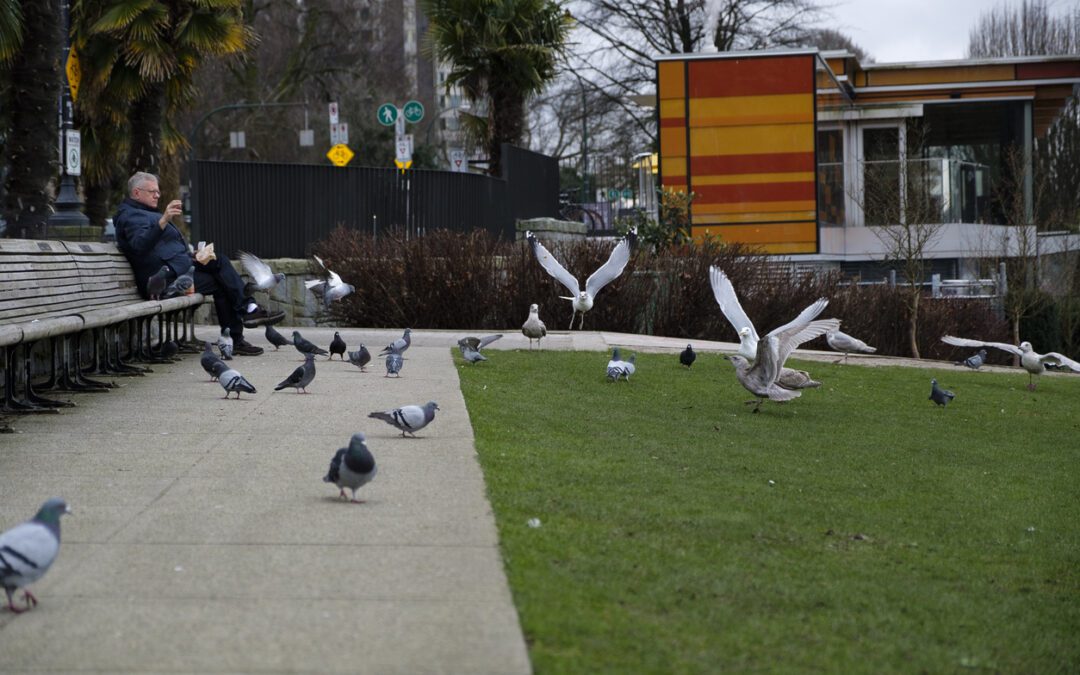
by Pigeon Patrol | Sep 25, 2024 | Bird Deterrent Products, Bird Netting, Bird Spikes, Columbidae
A man feeds the pifeons in Times Square in 1949 (and was probably beaten a short time later.)
Rats with wings, or majestic streetwise bird? It’s a debate that’s raged almost as long as New York City has been called that. And this week, the war between the two sides boiled over again.

Injured peace dove, crossing out word “PEACE” that on the road sign. (Used clipping mask)
It started when the exclusive University Club had its feathers ruffled. It wanted to drape its storied building in netting, to protect it from pigeon poo, which eats away at stone and metal. But the Landmarks Commission said it would have to wait for approval, as it would be a “visible change” to the landmarked Italian Renaissance building’s façade. As if the crap wasn’t a “visible change” enough.
Meanwhile, over on East 93rd Street, there was a scuffle involving longtime pigeon activist Anna Dove and her neighbor, who snatched away her bag of seed after he saw her feeding the pigeons on the sidewalk. The police were summoned.
“It’s disgusting,” said her nemesis, retired teacher Arthur Schwartz. “She’s feeding the rats.”
And with the live pigeon-shooting state championships in Pennsylvania coming up, it’s almost guaranteed that there will be an increase in demand of pigeon-poaching — New York City is a favorite spot for trapping them and transporting them to be used as live targets. The animal-rights activists will be out with their cameras and signs to stop them.
AD
No matter which side you’re on, one things for certain — by the end, things are going to get a little birdbrained.
*
“It’s not the pigeons that are the problem, it’s the number of them,” says Andrew D. Blechman, author of “Pigeons: The Fascinating Saga of the World’s Most Revered and Reviled Bird.” “They’re gentle creatures. The problem is that they get in our face, just like we get in each other’s faces.”
No one one’s quite sure of how many pigeons are in New York City. One adage is “one pigeon per person,” which would put their numbers at about 7 million. They each produce about 25 pounds of waste per year.
Pigeons love cities because of the many ledges, windowsills, eaves and rooftops available for them to roost in, which mimics their natural habitat of high cliffs. Pigeon pairings are monogamous, often mating for life, and both parents raise the babies — called squab — for a time, sitting on the eggs in shifts.
The pigeon includes about 298 species of bird, but the Rock Dove is the most common to the New York area, according to the Parks Department. The grey, bobbing-headed birds usually have purple-green iridescence around the neck area. They’re the scruffiest members of the dove family — although “dove” usually connotes the pure white symbols of peace, not the pizza scavengers of city streets. (Just say they’ve been pigeonholed.)
“If they were white,” Blechman says, “people would love them.”
Blame the French for our pigeon problems. The little pluckers first arrived in the early 1600s with French settlers who used them for meat. They were easy to raise — they could be kept in a barn, where they’d perch on the rafters, and young pigeons served as a good source of protein.
But they soon escaped their confines and went feral.
City life agreed with them and allowed them to flourish — and in some cases, over-flourish. Their natural predators, like falcons and hawks, aren’t found here in great numbers.
Courtney Humphries, author of “Superdove: How the Pigeon Took Manhattan . . . And the World,” concedes that pigeon are pilloried partly because of their “persistence. They nest on the buildings we consider our territory, and they don’t like to be moved.”
The average city pigeon has a lifespan of three to five years. With all the food scattered throughout the garbage cans and sidewalks — plus well-meaning human feeders — they spend less time looking for grub, which leaves more time for mating.
“The biggest problem is the people who overfeed them,” says Blechman. “Every city has about a dozen of them, and they’re the ones who cause the [overpopulation] problem.”
He suggests that if you want to feed the birds, hand out just a teaspoon full of birdseed for a flock. “It’s just enough to give them a little extra energy while they’re out trying to find their own food.”
“If nobody fed pigeons, I think things would look a lot different,” agrees Humphries, who says that human feeders end up creating dense flocks. “A lot of the problem with pigeons comes from people.”
If you can’t freeze the hearts of little old ladies, though, you could try eating them (the pigeons, that is). Squab — baby pigeons that haven’t flown yet — is on the menu at many restaurants around the city, particularly French. They’re “basically the milk-fed veal of the sky,” says Blechman — tender, mostly dark meat, and one of the only poultry that can be eaten rare. (Pigeons produce their own milk-like substance, which they feed to their young by regurgitation.)
Pigeon pot pie was a huge colonial favorite. Today, try the Squab and Foie Croustillant at the Modern, Danny Meyer’s restaurant at the Museum of Modern Art.
*
Unless the appetite for squab skyrockets, New York’s options are few. Avicide — poisoning birds — was made illegal in 2000, when the state Legislature passed a bill outlawing the use of “flock dispersal agents” like Avitrol in cities with more than 1 million people.
Before that, property managers regularly hired pest control services to dole out Avatrol to flocks of pigeons.
“In theory, you would mix it with feed, and when one pigeon ate some of the treated food, they would begin to suffer from neurological toxicity,” explained Stephanie Boyles, wildlife expert at the Humane Society of the United States. “When their flockmates saw them suffering, it would prompt them to leave the area.”
In practice, however, overdosing often led to large numbers of birds convulsing and writhing in pain on the street before their deaths. Welcome to New York!
The last major flare-up between pigeons and people was in 2007, when City Councilman Simcha Felder released a report plaintively titled, “Curbing the Pigeon Conundrum.”
Claiming that their droppings carried a host of diseases like histoplasmosis, he proposed a $1,000 fine to anyone feeding them, as well as curbing their numbers through birth control (a measure that cities like Los Angeles have adopted, although some argue that it’s unsustainable), and appointing a city “Pigeon Czar” to oversee other pigeon-control issues.
The NYC Department of of Health and Mental Hygiene maintains that contact with their droppings only poses a small health risk, and that “routine cleaning of droppings (e.g. from windowsills) does not pose a serious health risk to most people,” although disposable gloves are a good idea.
The Humane Society came out against the anti-feeding fine because they weren’t sure it would actually make a difference in reducing flocks, said Boyles. “We still suggest working with communities to create places where pigeons are welcome, and discouraging them where they’re not.”
While Felder’s bill didn’t fly, it was only one of many efforts to keep pigeons clipped.
In 2006, pigeon loitering was so dense near the Army Recruitment Center in Times Square, speakers were set up to broadcast sounds of falcons and pigeons being attacked, in hopes of scaring them away. In 2003, they had so overwhelmed Bryant Park that the operators invited a falconer and his hawk to the park for a week to scare away (not eat) the pigeons.
In 2007, the MTA installed Bird-B-Gone on some of its elevated stations along the 7 line, as well as others. The electronic system zapped birds that got too close.
In the ’80s, plastic owls were a big seller. Today, a slightly more high-tech version, called the RoboHawk, moves its head, wings, and makes what its creators hope are pigeon-threatening sounds.
Every so often, a politician considers reviving an overall anti-feeding bill, since, for now, it’s only illegal in city parks where signs are posted (the fine is usually $50).
Some cling to the hope that the city will come to its senses and declare war. Because they’re a non-native species, pigeons are not protected by either the Federal Migratory Birds Act or New York state laws. Can anyone say hunting season?
It’s got to be done mafia-style, though. Culling is only a temporary solution — as with most wild birds, quick breeding will put their numbers back to pre-cull figures within weeks, according to Pigeon Control Advisory Service.
*
But spare a thought, pigeon haters, for your majestic foe. Pigeons have more qualities than you think.
Although city birds aren’t particularly active, pigeons are built to be athletes — a trained bird can fly up to 60 miles per hour, and they can stay in the air for 500 miles. They’re meant for flying long distances, and have “homing” instincts, which means they will naturally find their way back.
This talent is why they were literally drafted into the United States Army Pigeon Service.
A million served in both world wars, where they delivered messages across enemy lines and saved thousands of soldiers’ lives. One pigeon, Cher Ami, won a French medal for his bravery for flying through gunfire, finally delivering the message dangling from what was left of his foot. He’s now stuffed and in the Smithsonian.
The army’s Pigeon Breeding and Training Center was based at Fort Monmouth, NJ, and opened in 1917. Many of its “Pigeoneers” were “basically just boys out of Brooklyn, and they’d just bring their best birds,” Humphries says. (The training center was closed in 1957 when the Army stopped using them as messengers.)
Keeping pigeons on rooftops — and racing them — used to be much more popular. Who can forget Marlon Brando’s character in the 1954 film “On the Waterfront” shouting up to his friend Joey, “I got one of your birds!” right before Joey “accidentally” falls off the roof?
The city is full of equally vocal bird-lovers.
“They animate our lives,” argues Blechman, who says that despite writing a book on pigeons, he is not a “bird person,” and admits to having eaten them before. He’s come around, though. “You look out the window and you can have a pigeon land on your windowsill, and the same one will come back every day, and at the same time.
“What would the lonely, the unemployed, and the elderly do every day if it weren’t for pigeons?”
The Internet is atwitter with kooky pigeon fans. There’s a pigeon appreciation society on Facebook. On photo-sharing site Flickr, there’s a group called The Global Pigeon Art Appreciation Society.
“You are not alone,” the site reads. “Many artists have been inspired by pigeons.”
There is also a city listserv called “New York Pigeon People,” where members discuss how to rescue birds and share pigeon news.
You can eat them, race them, breed them, feed them, but you can’t escape them, whether you consider them the most misunderstood creatures of the flying community or the world’s worst bird. As Blechman put it, “We’re just going to have to learn to co-exist.”
Pigeon Patrol
Pigeon Patrol Products & Services is the leading manufacturer and distributor of bird deterrent (control) products in Canada. Pigeon Patrol products have solved pest bird problems in industrial, commercial, and residential settings since 2000, by using safe and humane bird deterrents with only bird and animal -friendly solutions. At Pigeon Patrol, we manufacture and offer a variety of bird deterrents, ranging from Ultra-flex Bird Spikes with UV protection, Bird Netting, 4-S Bird Gel and the best Ultrasonic and audible sound devices on the market today.
Canada’s top wholesaler for bird deterrent products for twelve consecutive years.
Contact us at 1- 877– 4– NO-BIRD, (604) 585-9279 or visit our website at https://www.pigeonpatrol.ca/
Bird Gone, Pigeon Gone, Pigeon problems, pigeon spikes, 1-877-4NO-BIRD, 4-S Gel, Bird Control, Pigeon Control, bird repellent, Bird Spikes, sonic bird repellent, stainless steel bird spikes, bird spikes Vancouver, Ultra Sonic Bird Control, Bird Netting, Plastic Bird Spikes, Canada bird spike deterrents, Pigeon Pests, B Gone Pigeon, Pigeon Patrol, pest controller, pest control operator, pest control technician, Pigeon Control Products, humane pigeon spikes, pigeon deterrents, pigeon traps, Pigeon repellents, Sound & Laser Deterrents, wildlife control, raccoon, skunk, squirrel deterrent, De-Fence Spikes, Dragons Den, Pigeon, Pigeon Patrol, Pigeons Roosting, Vancouver Pigeon Control, Bird Spikes, Bird Control, Bird Deterrent, Pigeon Deterrent, Surrey Pigeon Control, Pest, Seagull deterrent Vancouver Pigeon Blog, Birds Inside Home De-fence, Pigeon Nesting, Bird Droppings, Pigeon Dropping, woodpecker control, Keep The Birds Away, Birds/rats, seagull, pigeon, woodpecker, dove, sparrow, pidgeon control, pidgeon problem, pidgeon control, flying rats, pigeon Problems, bird netting, bird gel, bird spray, bird nails, bird guard, Pigeon control, Bird deterrents, Pigeon deterrents, Bird control, solutions, Pigeon prevention, Pigeon repellent, Bird proofing, Pest bird management, Pigeon spikes, Bird netting, Humane bird control, Bird exclusion, Urban bird control, Anti-roosting devices, Pigeon removal, Bird barriers
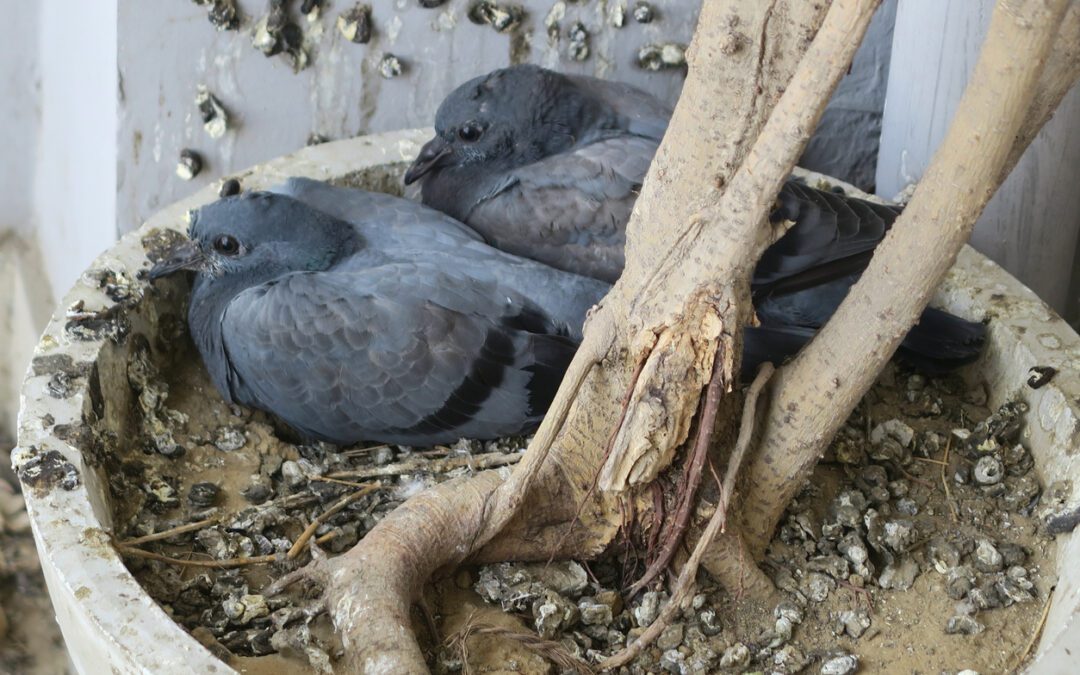
by Pigeon Patrol | Sep 25, 2024 | Bird Deterrent Products, Bird Law, Bird Netting
A controversial pesticide that has been banned through much of Europe and in New York City is being used to keep pigeons away from Red Deer’s downtown bus terminal.
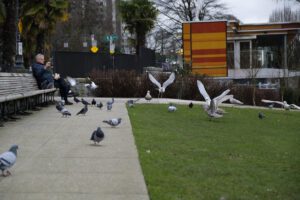
It’s a cloudy morning in British Columbia and it seems that this guy is accustomed to bring food for pigeons and seagullls.
A controversial pesticide that has been banned through much of Europe and in New York City is being used to keep pigeons away from Red Deer’s downtown bus terminal.
Steve Parkin, transit facilities superintendent for the City of Red Deer, confirmed on Wednesday that Calgary-based Abell Pest Control is using the pesticide, under the trade name of Avitrol, to stop pigeons from roosting at Sorensen Station.
The city contracted the company shortly after the station, on the corner of 49th Street and 49th Avenue, officially opened in September 2010.
Parkin said there were lots of pigeons at the time and they were “messing everywhere” with their droppings, which are considered a health hazard for humans. Bird spikes or nails were also installed to discourage birds from landing on the transit station.
Since this “anti-flocking agent” was introduced about a year to 18 months ago, Parkin said the pigeon population has been reduced.
Avitrol is placed in containers in the beams of the transit terminal.
“There’s still a couple of them flying around in there but not to the degree that it was, and the manure problem isn’t as bad,” said Parkin. “It’s feed that upsets their stomachs and make it a less desirable place, and they apparently rush off. The company tells us that they are funny creatures. If they can’t find a place they like and the food isn’t good, then they will move on.”
Parkin wasn’t certain what the agent was but after a phone call was made, he discovered it was Avitrol.
“They assured us it was a relatively safe way to control pigeons,” he said. “It won’t kill them, it affects their nerves, I guess.”
He said Inspections and Licensing Department, which controls the parkade above the transit terminal, is also using Abell Pest Control.
Calls to Abell Pest Control were not returned on Wednesday or Thursday.
Parkin said he wasn’t aware of any controversy surrounding Avitrol.
“All we did was contracted a certified pest control and that’s what they recommended,” he said.
Opponents of the chemical claim it’s inhumane and that it poisons non-target species that consume the bait or the carcasses of birds that have died as a result.
Carol Kelly, executive director for Medicine River Wildlife Centre near Spruce View, said Red Deer residents should be disappointed.
“It’s highly toxic and definitely deadly and goes up the food chain to peregrine falcons,” said Kelly. “Maybe in low dosages, some of those pigeons might recover. But I would not want to have that stuff spread around my community.”
Kelly is working to bring OvoControl, a birth control bait system for birds, to Canada. It’s being used across the United States and is getting good reviews for its effectiveness, she added.
According to the Avitrol website, the agent works on the central nervous system and the motor nervous system. Its action on the motor nervous system usually causes behaviours characteristic of those seen in an epileptic seizure.
The website also refers to renowned animal welfare advocate Dr. Harry C. Rowsell, who in his Assessment of Humaneness of Vertebrate Pesticides report from 1979, said that “although the ingestion of this product is visually repugnant, our studies suggest that the chemical does not cause pathological changes in the organs or tissues capable of causing pain or distress.”
“Birds eating the treated bait will be affected in a manner that, varying by species, will artificially cause them to emit distress and alarm cries and visual displays used by their species when they are frightened or injured,” says the website. “This may include flying erratically, vocalizing, trembling, dilation of the pupils and other symptoms indicative of loss of motor control. This will frighten the flock and cause it to leave the site.”
In laboratory testing, if the dose is lethal, death will usually occur within an hour following administration, reports the website.
The Ontario Ministry of Natural Resources has strict regulations surrounding the use of Avitrol, including disposing of any exterminated animals daily to prevent contact with humans or other animals. The restrictions are crucial as the province tries to protect threatened birds of prey and in particular, peregrine falcons, which like to eat pigeons.
Avitrol was developed to deter songbirds from damaging crops. As soon as the first few birds are intoxicated, they issue loud warning cries and the rest of the songbirds fly away.
“In other words, it was developed for birds who have a physiological ability to utter a distress call,” said Canadian naturalist Barry Kent MacKay in a 1999 article with the St. Louis-based The Riverfront Times. “Pigeons don’t. They cannot utter these loud alarm notes.”
New York state legislators were so concerned about the use of Avitrol that they banned it from use in major metropolitan areas such as New York City in 2000.
The Humane Society of the United States has described Avitrol as a poison that is not only unnecessary, but dangerous. It advocates effective humane solutions like the use of OvoControl as well as devices that keep birds off rooftops, windowsills and similar surfaces
Pigeon Patrol
Pigeon Patrol Products & Services is the leading manufacturer and distributor of bird deterrent (control) products in Canada. Pigeon Patrol products have solved pest bird problems in industrial, commercial, and residential settings since 2000, by using safe and humane bird deterrents with only bird and animal -friendly solutions. At Pigeon Patrol, we manufacture and offer a variety of bird deterrents, ranging from Ultra-flex Bird Spikes with UV protection, Bird Netting, 4-S Bird Gel and the best Ultrasonic and audible sound devices on the market today.
Canada’s top wholesaler for bird deterrent products for twelve consecutive years.
Contact us at 1- 877– 4– NO-BIRD, (604) 585-9279 or visit our website at https://www.pigeonpatrol.ca/
Bird Gone, Pigeon Gone, Pigeon problems, pigeon spikes, 1-877-4NO-BIRD, 4-S Gel, Bird Control, Pigeon Control, bird repellent, Bird Spikes, sonic bird repellent, stainless steel bird spikes, bird spikes Vancouver, Ultra Sonic Bird Control, Bird Netting, Plastic Bird Spikes, Canada bird spike deterrents, Pigeon Pests, B Gone Pigeon, Pigeon Patrol, pest controller, pest control operator, pest control technician, Pigeon Control Products, humane pigeon spikes, pigeon deterrents, pigeon traps, Pigeon repellents, Sound & Laser Deterrents, wildlife control, raccoon, skunk, squirrel deterrent, De-Fence Spikes, Dragons Den, Pigeon, Pigeon Patrol, Pigeons Roosting, Vancouver Pigeon Control, Bird Spikes, Bird Control, Bird Deterrent, Pigeon Deterrent, Surrey Pigeon Control, Pest, Seagull deterrent Vancouver Pigeon Blog, Birds Inside Home De-fence, Pigeon Nesting, Bird Droppings, Pigeon Dropping, woodpecker control, Keep The Birds Away, Birds/rats, seagull, pigeon, woodpecker, dove, sparrow, pidgeon control, pidgeon problem, pidgeon control, flying rats, pigeon Problems, bird netting, bird gel, bird spray, bird nails, bird guard, Pigeon control, Bird deterrents, Pigeon deterrents, Bird control, solutions, Pigeon prevention, Pigeon repellent, Bird proofing, Pest bird management, Pigeon spikes, Bird netting, Humane bird control, Bird exclusion, Urban bird control, Anti-roosting devices, Pigeon removal, Bird barriers










